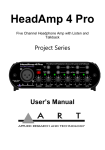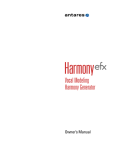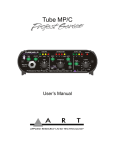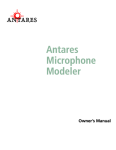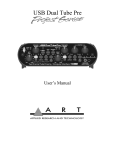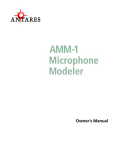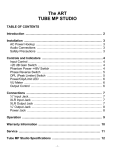Download Antares Auto-Tune 5 User`s manual
Transcript
Auto-TunePre Tube Preamp powered by Antares® Auto-Tune® Project Series User’s Manual IMPORTANT SAFETY INSTRUCTION – READ FIRST This symbol, whenever it appears, alerts you to the presence of uninsulated dangerous voltage inside the enclosure-voltage that may be sufficient to constitute a risk of shock. This symbol, wherever it appears, alerts you to important operating and maintenance instructions in the accompanying literature. Please read the manual. Read instructions: Retain these safety and operating instructions for future reference. Heed all warnings printed here and on the equipment. Follow the operating instructions printed in this user manual. Do not open: There are no user serviceable parts inside. Refer any service work to qualified technical personnel only. Power sources: Connect the units power supply to mains power only of the type described in this user manual or marked on the power supply. Power supply: Use the power supply with sealed mains plug appropriate for your local mains supply as provided with the equipment. If the provided supply does not fit into your outlet consult your service agent. Route the power cord so that it is not likely to be walked on, stretched or pinched by items placed upon or against it. Grounding: Do not defeat the grounding and polarization means of the power supply. Moisture: To reduce the risk of fire or electrical shock do not expose the unit to moisture or use in damp or wet conditions. Do not place container of liquid on unit. Heat: Do not locate the unit close to excessive heat or direct sunlight, as this could cause a fire hazard. Locate the unit away from any equipment, which produces heat such as: power supplies, power amplifiers and heaters. Environment: Protect from excessive dirt, dust, heat, and vibration when operating and storing. Avoid tobacco ash, drink spillage and smoke, especially that associated with smoke machines. Handling: Protect the controls from damage during transit. Use adequate padding if you need to ship the unit. To avoid injury to yourself or damage to the equipment, take care when lifting, moving, or carrying the unit. Servicing: Unplug power immediately if equipment is exposed to moisture, the power supply becomes damaged during a lightning storm or if smoke odor or noise is noted. Refer servicing to qualified technical personnel only. Installation: Install the unit in accordance with the instructions printed in the user manual. 2 INTRODUCTION The Auto-Tune Pre combines an ART tube preamp channel with integrated Antares® Auto-Tune® processing in a compact easily accessible package ideal for studio or stage. Now live artists can easily add high quality Antares pitch processing without the complexity and cost of an external computer and software. The Antares Auto-Tune EFX section of the product is designed to have a user interface and functionality that is similar to the Auto-Tune EFX Plug-in software. Users can select the Key, Scale, and EFX type. Individual notes can be toggled on or off using the key pads for more customization. Edits can be stored in one of five footswitch accessible presets (footswitch optional). The ultra low noise discrete microphone preamp front end has an extremely flat and wide frequency response and handles a wide range of input signal levels with a minimum of coloration. The tube circuit uses a high quality hand selected 12AX7A tube to add warmth to the signal path. An insert jack allows external processing to be added between the Preamp and AutoTune EFX section. The ¼-inch Footswitch jack on the rear allows remote access to the Bypass and Preset functions. Key Features • • • • • • • • Antares Auto-Tune® Processing Selectable Pitch Correction Effect (from subtle to obvious) Five User Programmable Presets High Quality Class-A Tube Preamp +48 Volt Phantom Power +4dBm / -10dBv Selectable Output Level Insert Jack Remote Footswitch Jack (Bypass & Presets – footswitch optional) 3 CONNECTIONS The INPUT “Combo” jack allows for either XLR or ¼-inch TRS input connections. The XLR input connection is used primarily for balanced microphone input. Pin 2 is positive, pin 3 is negative, and pin 1 is ground. +48 Volt phantom power (when enabled) is supplied to pins 2 and 3. Pin 1 acts the ground return. Do not lift pin 1 when using phantom power. If you are using the XLR Input with a balanced line level signal or a microphone that does not require phantom power, make sure that phantom power is turned off. This input can handle signals up to +14dBu before clipping. The ¼-inch input connection is used for high impedance microphones or low line level unbalanced (TS) signals. The high fixed input impedance minimizes microphone loading. This input can handle input signals up to +15dBu. The INSERT jack allows you to add external processing between the Preamp and Auto-Tune EFX section. This also gives you a direct out from the preamp (pre AutoTune) and allows you to directly drive the Auto-Tune EFX section if you are using an external preamp or line level source. The REMOTE jack allows for external control of the Bypass and Preset switch functions. The Preamp section is not affected. If you use an external footswitch with two switches through a ¼-inch TRS connection, then the switch connected to the Tip toggles the Bypass function and the switch connected to the Ring lets you step through the Presets. If you plug a single remote footswitch with a Mono ¼-inch (TS) connection into the jack it will step through the Presets. If you want to toggle Bypass only with a single remote footswitch, use a ¼-inch TRS connection that has only the tip and sleeve connected (floating ring). Momentary type footswitches should be used that are normally open and close only when pushed. The remote footswitch will act just like the front panel switches. 4 The ¼-inch MAIN OUTPUT jack is unbalanced with an output impedance of 300 Ohms. The maximum output level is +18dBu. The XLR MAIN OUTPUT jack is balanced with an output impedance of 600 Ohms. The maximum output level is +24dBu. It can provide clean balanced signals for long cable runs. The 9 Volts AC power connector on the rear should only be connected to the power supply that comes with the unit (9 Volts AC @ 1000 mA). Make sure that you specify AC and not DC if you have to replace this supply. Internal circuitry converts this power to the higher voltages needed for the tube and phantom power sections. REAR PANEL SWITCHES The POWER switch allows you to power off the unit when it is not in use. Please allow the tube and internal circuitry to warm up for one to two minutes before use if the unit has been powered off. Remember to turn the Auto-Tune Pre on before turning on any monitoring or power amplifiers. The OUTPUT LEVEL switch adjusts the main output levels at both output jacks to accommodate either high level (+4dBm) or low-level (-10 dBv) type of systems. If you want to plug directly into an instrument amplifier or microphone level input then set the switch to –10dBv. If you want a “hot” signal to drive down a long cable to a line level input then set the switch to +4dBm. By doing this, you maximize the signal to noise performance of your system. The LOW CUT FILTER switch, when engaged, reduces very low frequency bass response of the microphone preamp. This helps to minimize low frequency rumble and wind and microphone handling noise when using microphones in live settings. The PHANTOM POWER switch applies +48 Volt phantom power to the XLR input jack for microphone powering, if needed. It turns on and off slowly and is current limited to protect sensitive microphones and reduce audible pops. Ideally, when connecting a microphone that requires phantom power, you should first turn down gain, then connect the microphone, then switch on the phantom power, and finally bring the gain back up to the desired level. This minimizes pops in your system and stress on the microphone. 5 CONTROLS AND OPERATION PREAMP SECTION CONTROLS The GAIN control directly adjusts the input amplifier’s gain, giving you control over the dynamic range of your source. You get from 0 to 48dB of gain depending on settings. Set this control counterclockwise to minimum gain when first connecting the input jack. The GAIN switch adds 20dB more to the preamp gain. This is useful when you need more gain than the input GAIN control can provide. LED metering circuitry aids in setting gain. It has a fast attack to indicate any clipping. The metering is located in the signal chain just after the preamp section and displays the signal level going to the Auto-Tune section. The red CLIP LED comes on at 3dB before clipping and should light on musical peaks. The green SIGNAL LED comes on at 20dB below the CLIP LED. It should be on most of the time during performance and, if not, it indicates that your signal level or input gain may be too low for best preamp and Auto-Tune section performance. The OUTPUT control adjusts the signal level that is sent to the Main output connections. This signal level is after both the Preamp and Auto-Tune sections. PREAMP SECTION SETUP First plug your microphone or signal source in and turn on phantom power if needed. Increase the Gain control on the front until the Signal LED comes on and the Clip LED lights briefly on peaks. If you need more gain than the Gain control can provide, then use the Gain switch. Next, turn up the Output control until the output signal level is correct for your system. By doing this, you optimize the dynamic range of your system. Make sure the Output level switch is set to the –10dBv setting if you are running into a microphone preamp or instrument amplifier for best noise performance. 6 AUTO-TUNE SECTION CONTROLS The Auto-Tune section is designed to have a user interface and functionality that is similar to the Antares® Auto-Tune EFX Plug-in software. Users can select the Key, Scale, and EFX type. Individual notes can be toggled on or off using the Note key pads for more customization. Bypass and Preset switches enhance live operation. AUTO-TUNE SECTION SETUP First, set the Key by pressing the KEY button. You can cycle through the top row of 12 LEDs as you continue to press this button. If you do not know the Key that your song is in, the Auto-Tune Pre has a built-in tone generator that (like a pitch pipe) generates an actual output tone. To use this feature, merely press and continue to hold one of the Note buttons. After 2 seconds a tone will be produced at the audio outputs. This tone corresponds to the pitch of the Note button. After trying a few Note buttons, you should find a Note that works well with your song. Set the Key to be that Note as a starting point. Next, select the Scale (Major, Minor, Chromatic) by pressing the SCALE button. Major and Minor are both seven-tone equal tempered scales. Chromatic is a 12-tone equal tempered scale (all 12 Notes will be lit regardless of Key setting). If you are unsure of what Scale setting you want just toggle through the Scale settings and listen to the overall “character” of your song. You should find one setting that sounds better and more pleasing. Once you have chosen the Key and Scale, the appropriate rectangular Note buttons in the key pad area will light to indicate that they are in the scale and that the input vocal can be corrected or forced to these Notes. Depending on the specific vocal line, adding or removing scale Notes can give you distinctly different results. If you want, you can customize your scale by clicking on Note buttons to add or remove them from the scale. As you remove more Notes from the scale, the output becomes more robotic sounding. Next, select the desired effect by pressing the EFX TYPE button. Hard EFX is the iconic Auto-Tune Vocal Effect popularized by innumerable artists in virtually every genre of popular music. Soft EFX allows slight pitch variations and slightly less instant Note transitions. Pitch Correct provides high-quality, real-time correction of intonation problems, while preserving all the expressive nuance of the original performance. That is it in terms of setting up the Auto-Tune section. If you want to save your latest settings, simply press the STORE switch and the new settings will be saved to the 7 current Preset. The Preset LED will flash momentarily to let you know that the new settings are being stored. The state of the BYPASS switch is also saved with the preset information so any preset can be recalled in bypass mode. The PRESET switch and 5 Preset LEDs are designed to enhance live operation. Momentarily pushing the switch cycles through the 5 presets. Whatever Auto-Tune settings were indicated when you last saved a particular preset are recalled the next time that you go to that preset. While you are on a preset, if you change any of the AutoTune settings, the change happens right away, and if you then press the STORE button the change will be remembered for the next time the preset is chosen. Now that you know how the controls work, perhaps some explanation of what AutoTune processing is doing to the audio will help. What does it do? The Antares Auto-Tune processing in the Auto-Tune Pre lets you choose between real-time pitch correction and two different flavors of the Auto-Tune Vocal Effect. Pitch Correction Auto-Tune pitch correction works by continuously tracking the pitch of your vocal and comparing it to the notes in the (user-customizable) scale of your song. The scale note closest to the input pitch is identified as the target note. If the vocal’s pitch exactly matches the target note, no correction is applied. If the vocal’s pitch varies from the target note, either sharp or flat, the output pitch is smoothly corrected to the target note. Auto-Tune Vocal Effect The Auto-Tune Vocal Effect is what is technically known as “pitch quantization”. That is, instead of allowing all of the small variations in pitch and the gradual transitions between notes that are a normal part of singing (and speaking, for that matter), the Auto-Tune Vocal Effect limits each note to an exact pitch, stripping out any variation, as well as forcing instantaneous transitions between notes. The process of choosing the pitches to quantize to is the same as described above for pitch correction. The difference is that, for pitch correction, the correction is done smoothly in order to make the process as transparent as possible. For the Auto-Tune Vocal Effect, the correction is instantaneous. For more tips, techniques, and information on the Auto-Tune® process visit: www.antarestech.com 8 WARRANTY INFORMATION Limited Warranty Applied Research and Technology will provide warranty and service for this unit in accordance with the following warrants: Applied Research and Technology, (A R T) warrants to the original purchaser that this product and the components thereof will be free from defects in workmanship and materials for a period of three years from the date of purchase. Applied Research and Technology will, without charge, repair or replace, at its option, defective product or component parts upon prepaid delivery to the factory service department or authorized service center, accompanied by proof of purchase date in the form of a valid sales receipt. Exclusions This warranty does not apply in the event of misuse or abuse of the product or as a result of unauthorized alterations or repairs. This warranty is void if the serial number is altered, defaced, or removed. A R T reserves the right to make changes in design or make additions to or improvements upon this product without any obligation to install the same on products previously manufactured. A R T shall not be liable for any consequential damages, including without limitation damages resulting from loss of use. Some states do not allow limitations of incidental or consequential damages, so the above limitation or exclusion may not apply to you. This warranty gives you specific rights and you may have other rights, which vary from state to state. For units purchased outside the United States, an authorized distributor of Applied Research and Technology will provide service. SERVICE The following information is provided in the unlikely event that your unit requires service. 1) Be sure that the unit is the cause of the problem. Check to make sure the unit has power, all cables are connected correctly, and the cables themselves are in working condition. You may want to consult with your dealer for assistance in troubleshooting or testing your particular configuration. 2) If you believe the ART unit is at fault, go to www.artproaudio.com. You may contact Customer Service for more assistance, or directly request a Return Authorization for service in the “resources” area of the website. 3) If you are returning the unit for service, pack the unit in its original carton or a reasonable substitute. The original packaging may not be suitable as a shipping carton, so consider putting the packaged unit in another box for shipping. Print the RA number clearly on the outside of the shipping box. 4) Include, with your unit, a note with the RA number and your contact information including a daytime phone number, preferably attached to the top of the unit. 9 SPECIFICATIONS Input Connections: XLR-Female balanced or ¼-inch unbalanced Output Connections: XLR-Male balanced and ¼-inch unbalanced Frequency Response: 20 Hz – 20 kHz, +/-1dB (typical) Dynamic Range: >104dB A-weighted Tube Type Hand Selected 12AX7A (x1) THD: <0.05% (typical) CMRR: >60dB (typical) Maximum Input Level: +16dBu (¼-inch), +15dbu (XLR), +16dBu (Insert) Maximum Output Level: +18dBu (¼-inch), +24dbu (XLR), +16dBu (Insert) Low Cut Filter: Switchable, –3dB @ 100 Hz Input Impedance: 5.5k Ohm(balanced XLR), 1M Ohm(unbalanced ¼-inch) Output Impedance: 600 Ohm(balanced XLR), 300 Ohm(unbalanced ¼-inch) Maximum Gain: Switchable, +66dB (balanced in-out) Phantom Power: Switch selectable, +48Volts DC, filtered, current limited Chassis Type: Aluminum anodized with integral/stackable rubber sides Power Requirements: 9VAC @ 700mA (typical) 9VAC @ 1000mA supply included with product Dimensions: 1.75inch H x 5.9inch W x 6.5inch D 44.5mm x 150mm x 165mm Weight: 2.5 lbs. (1.14 kg) Note: 0 dBu = 0.775Vrms ART maintains a policy of constant product improvement. Therefore, specifications are subject to change without notice. Go to www.artproaudio.com for the latest information and on the Auto-Tune Pre. Go to www.antarestech.com for more information on Antares® and Auto-Tune®. 10 11 www.artproaudio.com E-mail: [email protected] Copyright © 2013 Applied Research & Technilogy 12 Auto-Tune Pre 183-5004-100













